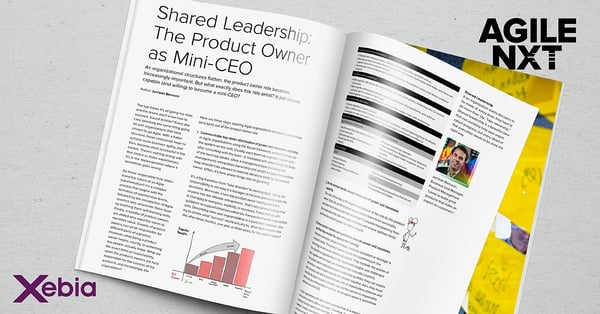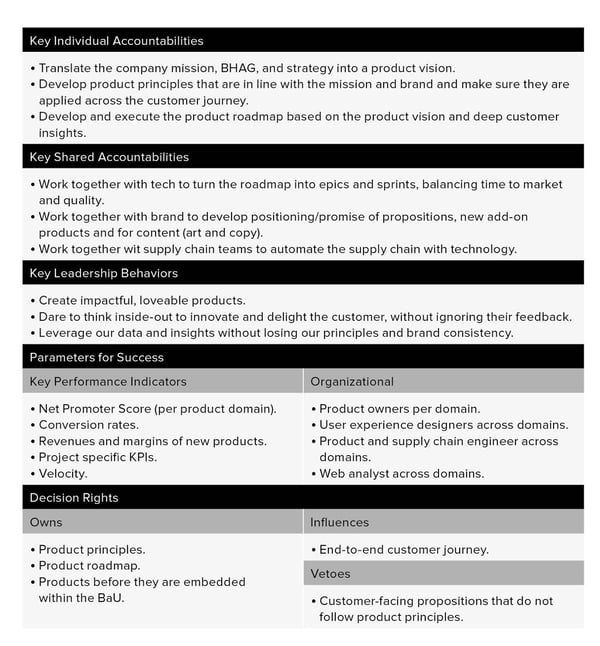As organizational structures flatten, the product owner role becomes increasingly important. But what exactly does this role entail? Is just anyone capable (and willing) to become a mini-CEO?
The top thinks it's all going too slow, and the teams don't know how to succeed. Sound familiar? Every day I see precisely the same thing going on with organizations that have chosen to go Agile. With a flatter structure, these companies hope to achieve more business agility, and thus, become more successful in the market. There’s nothing wrong with that choice or those expectations; it’s in the implementation where it sometimes goes wrong.
Do those responsible truly understand the nature of an Agile transformation? It’s a complex process that begins with the formation of autonomous teams, followed by the introduction of Agile coaches who accelerate those team by teaching them self-learning skills. Finally, a handful of product owners are added who need the vision to maximize value. Dozens of product owners can all be responsible for different parts of a product.
This article is published in  . Agile NXT is a new magazine full of inspiration for professionals on the emerging Agile journey. It challenges you to think differently and improve yourself, your team, and company a little more each day.
. Agile NXT is a new magazine full of inspiration for professionals on the emerging Agile journey. It challenges you to think differently and improve yourself, your team, and company a little more each day. 
However, what being a product owner means, exactly, is something few people actually know. What are the exact limits of responsibility, when the products owners are held responsible for the success of the products, and increasingly, the organization?
Here are three steps aspiring Agile organizations can take to get the most (and best) out of the product owner role:
1. Communicate top-down distribution of power and mandates explicitly.
In Agile organizations using the Scrum framework, product owners are the spiders on the web. Usually, each team has a product owner who - after consulting with the team - is mandated with determining the focus of the next two weeks. Once a management layer (including top
management) relinquishes ownership and adopts a supportive position, they shouldn’t be allowed to overrule decisions made by the product owner. Often, it's here where things start to go wrong.
It’s a big transition from “take direction” to working Agile. Taking full responsibility is not easy if a manager or the boss previously made the decisions. Moreover, a two-day product owner training won't turn anyone into the ultimate entrepreneur. That's why communicating what
is changing to everyone, explicitly, is necessary. Follow that up with guidance to support initiatives within the frameworks that the organization sets. Describing roles and responsibilities is a good start. However, also try to define what "success" would actually be. What does success look like after three months, one year, or three years, for the product owner?

2. As the product owner, accept handovers of power and mandates explicitly.
The next critical step is the explicit acceptance of the role by the product owner. Does the product owner know what it takes to be successful, and does he or she accept that challenge? Complete transparency from the onset about the role and responsibilities will ensure optimal clarity and that the product owner can deliver results.
3. Ensure product owners are qualified to execute power and mandates
and that they receive the appropriate training.
Not every developer, project manager, business consultant or manager is a product owner. The product owner knows the customer/user, the technology as well as the commercial aspect. They translate the wishes of the customer or opportunities in the market into insights and challenges that, together with the team, are translated into concrete solutions. The product owner must also possess leadership qualities: they can inspire and enthuse a team to work towards the solution together. Also, they must be a connector and able to communicate with all stakeholders (internal and external). Because it's such a versatile role and the person is responsible for the success of the product or service, the product owner is sometimes referred to as a mini-CEO.
In larger organizations, this role is more complex than in a startup or scaleup where there is often a clear goal. Therefore, the right training and coaching of product owners are essential. Too often, project managers, managers, analysts, and developers receive two days of training and a certificate and are then given the responsibilities of a product owner. However, it takes much more investment than that to develop people into mini-CEOs who can indeed handle the job.
Shared Leadership
If an organization wants decisions to be made at every level, they have to do more than say, “take ownership.” Shared leadership is a beautiful idea that can certainly help your organization progress, but every detail of that execution needs to be done the right way.
Want to know more about Agile Product Ownership? Download  and start your personal change tomorrow.
and start your personal change tomorrow.






